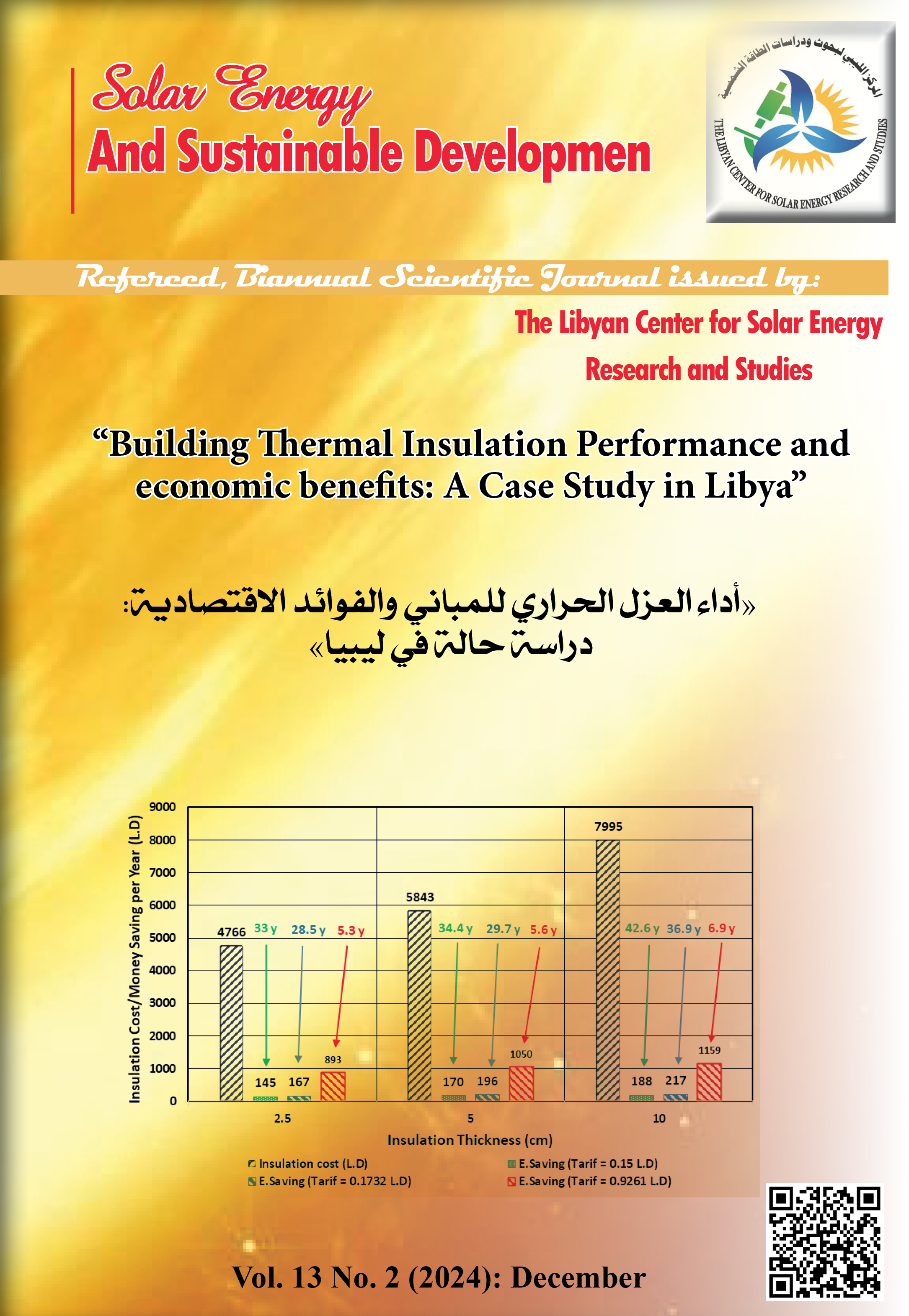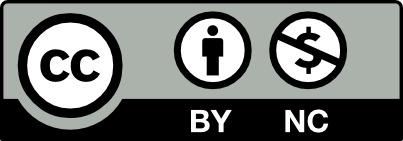Building Thermal Insulation Performance and economic benefits:
A Case Study in Libya
DOI:
https://doi.org/10.51646/jsesd.v13i2.197الكلمات المفتاحية:
Energy Plus، Polystyrene، insulation thickness، insulation density.الملخص
تم دراسة ثلاثة سيناريوهات مختلفة للعزل باستخدام برنامج Energy-plus لدراسة تأثير استخدام ألواح البوليسترين الممدد على استهلاك الطاقة في المباني في المركز الليبي لأبحاث ودراسات الطاقة الشمسية. وتشمل السيناريوهات الثلاثة السقف العازل والجدران الخارجية والسقف والجدران الخارجية. تم دراسة ثلاثة سماكات مختلفة لعوازل البوليسترين (2.5 سم، 5 سم، 10 سم) وكثافات مختلفة (15 كغم/م3، 25 كغم/م3، 35 كغم/م3). تم حساب التكلفة الإجمالية للبوليسترين، وفترة الاسترداد، وإجمالي وصافي الوفر المالي باستخدام العزل، بالإضافة إلى نسبة الوفر لكل حالة في السيناريوهات الثلاثة التي تمت دراستها لمدة 50 عامًا. أكثر السيناريوهات وفراً للمال بعد 50 عاماً هو عزل سطح المبنى والجدران الخارجية معاً بمتوسط سمك عزل 7 سم، حيث يصل الوفر خلال المدة المدكورة إلى حوالي 78000 د.ل حسب تعريفة 0.9261 د.ل /ك.و.ساعة. في حين أن الأقل وفراً هو سيناريو السقف فقط بسمك عازل 2.5 سم ويصل إلى أكثر من 29000 د.ل عند استخدام نفس التعريفة. أعلى قيم لنسب الكسب هي 76%، 103% و1090% عند سيناريو السقف، وسمك العزل 2.5 سم fتعريفات طاقة 0.15 ل.د/ك.و.س، 0.1732 ل.د/ك.و.س و0.9261 ل.د/ك.و.س، على التوالي. في حين أن أقل قيم لنسب الكسب حوالي 17.5% و35.7% و725% عند سيناريو الجدار بسمك عزل 10 سم وتعرفة الطاقة 0.15 ل.د/ك.و.س، 0.1732 ل.د/ك.و.س و0.9261 ل.د/ك.و.س على التوالي. تعتمد فترة الاسترداد لتكلفة العزل الإجمالية بشكل كبير على سمك العزل وتعريفة الطاقة.
التنزيلات
المقاييس
المراجع
GECOL, “General Electric Company of Libya (Statistics of 2012),” Tripoli, Libya, 2016. [Online]. Available: https://web.archive.org/web/20150924021233/http://www.gecol.ly/resources/documents/reports/static_ar_2012.pdf.
M. Abdunnabi, I. H. Tawil, M. Benabeid, M. A. Elhaj, and F. Mohamed, “Design of Solar Powered Space Heating and Domestic Hot Water System for Libyan Common House,” in 2021 12th International Renewable Energy Congress (IREC), 2021, pp. 1–6, doi: 10.1109/IREC52758.2021.9624800. DOI: https://doi.org/10.1109/IREC52758.2021.9624800
A. Bolattürk, “Determination of optimum insulation thickness for building walls with respect to various fuels and climate zones in Turkey,” Appl. Therm. Eng., vol. 26, no. 11–12, pp. 1301–1309, 2006. DOI: https://doi.org/10.1016/j.applthermaleng.2005.10.019
A. Bolattürk, “Optimum insulation thicknesses for building walls with respect to cooling and heating degree-hours in the warmest zone of Turkey,” Build. Environ., vol. 43, no. 6, pp. 1055–1064, 2008, doi: https://doi.org/10.1016/j.buildenv.2007.02.014. DOI: https://doi.org/10.1016/j.buildenv.2007.02.014
K. Alshaibani, F. Almaziad, M. Y. Numan, and I. Almofeez, “Glazing Openings and Thermal Insulation in Saudi Arabia.” Mar. 29, 2015. DOI: https://doi.org/10.4197/Env.8.4
S. K. Alghoul, A. O. Gwesha, and A. M. Naas, “The effect of electricity price on saving energy transmitted from external building walls,” Energy Res. J, vol. 7, pp. 1–9, 2016. DOI: https://doi.org/10.3844/erjsp.2016.1.9
E. Amiri Rad and E. Fallahi, “Optimizing the insulation thickness of external wall by a novel 3E (energy, environmental, economic) method,” Constr. Build. Mater., vol. 205, pp. 196–212, 2019, doi: https://doi.org/10.1016/j.conbuildmat.2019.02.006. DOI: https://doi.org/10.1016/j.conbuildmat.2019.02.006
M. Albizanti, A. Shinshin, A. Zgalei, and S. Alghoul, “The impact of the costs associated with adding thermal insulation to the exterior walls of buildings on optimal thickness and payback period,” J. Sol. Energy Sustain. Dev., vol. 11, no. 1, pp. 24–33, 2022.
S. Dardouri, S. Mankai, M. M. Almoneef, M. Mbarek, and J. Sghaier, “Energy performance based optimization of building envelope containing PCM combined with insulation considering various configurations,” Energy Reports, vol. 10, pp. 895–909, 2023, doi: https://doi.org/10.1016/j.egyr.2023.07.050. DOI: https://doi.org/10.1016/j.egyr.2023.07.050
Q. Al-Yasiri and M. Szabó, “Building envelope-combined phase change material and thermal insulation for energy-effective buildings during harsh summer: Simulation-based analysis,” Energy Sustain. Dev., vol. 72, pp. 326–339, 2023, doi: https://doi.org/10.1016/j.esd.2023.01.003. DOI: https://doi.org/10.1016/j.esd.2023.01.003
N. A. Aboudh, “Integration of photovoltaic cells in building shading devices: Enhancing energy efficiency and indoor environment in administrative building,” J. Sol. Energy Sustain. Dev., vol. 13, no. 2, pp. 83–101, 2024. DOI: https://doi.org/10.51646/jsesd.v13i2.230
A. O. S. A. F. M. Alghnain, I. A. Bernaz, “Power consumption analysis of the engineering affairs building of the Libyan Center for Solar Energy Research and Studies,” Sol. Energy Sustain. Dev. J., vol. 11, no. 1, pp. 34–46, 2022.
The National Renewable Energy Laboratory (NREL, “EnergyPlus.” U.S. Department of Energy’s (DOE) Building Technologies Office (BTO, 2022, [Online]. Available: https://energyplus.net/.
The National Renewable Energy Laboratory (NREL), “Welcome to OpenStudio® SDK User Documentation,” 2024. https://nrel.github.io/OpenStudio-user-documentation/.
Council of Ministers, “Resolution No. 647 of 20220 AD to determine the prices of selling electricity,” 2022. .
D. P. P. Meddage, A. Chadee, M. T. R. Jayasinghe, and U. Rathnayake, “Exploring the applicability of expanded polystyrene (EPS) based concrete panels as roof slab insulation in the tropics,” Case Stud. Constr. Mater., vol. 17, p. e01361, 2022, doi: https://doi.org/10.1016/j.cscm.2022.e01361. DOI: https://doi.org/10.1016/j.cscm.2022.e01361
N. Llantoy, M. Chàfer, and L. F. Cabeza, “A comparative life cycle assessment (LCA) of different insulation materials for buildings in the continental Mediterranean climate,” Energy Build., vol. 225, p. 110323, 2020, doi: https://doi.org/10.1016/j.enbuild.2020.110323. DOI: https://doi.org/10.1016/j.enbuild.2020.110323
M. Mequignon and H. A. Haddou, “Impact of the lifespan of building external walls on depletion of natural resources,” IFAC-PapersOnLine, vol. 48, no. 3, pp. 351–356, 2015. DOI: https://doi.org/10.1016/j.ifacol.2015.06.106

التنزيلات
منشور
كيفية الاقتباس
إصدار
القسم
الرخصة
الحقوق الفكرية (c) 2024 Solar Energy and Sustainable Development Journal

هذا العمل مرخص بموجب Creative Commons Attribution-NonCommercial 4.0 International License.













